H O M E • V
O R T E X 1 • V
O R T E X 2 • V
O R T E X 3 • V
O R T E X 4 • V
O R T E X 5 •
P E R S O N A
L B L O G

 |
| War
Art And Artists: Objets d’art’
and the Paraphernalia of War |
||
 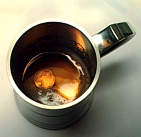
|
Alison Branagan:
Anti-war medals and The King's Shilling
tankard "My work addresses a wide variety of themes that often link with one another - brutality, conflict, decay, and death ritual. I research my ideas by placing the work in sympathetic locations such as military collector's shops, making links with a mythical past that makes the work itself look as if it is stranded and defunct, like a discarded curiosity." - excerpt taken from artists statement for Art Review UK (Nov / Dec. 1999) Brutality and Kings' Shilling Medals The medals are fashioned from a collection of metals traditionally associated with the historic metallic decoration. The sliced faced is reflective of the tradition within many cultures, including our own, of wearing a severed body of a defeated foe. Circular disks attached to other medals are often in fact King's Shillings. The silver shilling was traditionally given to the press-ganged or the eager volunteer as a token. To me the shilling represents the man, the repetitious stamp of the king, and the uniformity of the coins and faded males image reflects the passing of the nameless conscripts. I am usurping the usual context of a shiny gong-like medal awarded to the mother of a wife or a dead soldier. The work is a comment on unjust sacrifice, and on the values attached to the medal, coin and contemporary art dealing markets. The King's Shilling tankard 'These straight sided cast pewter tankards are based on a traditional design from the period 1790 - 1815. A 1787 George III Shilling is placed in the base between two plates of glass. The idea relates to the infamous time of press-ganging during the Napoleonic Wars. When an unsuspecting patron drank and took the strange 'object' from the bottom of the their drink they were pounced upon by waiting 'representatives' of the Navy or Army. As the hand sways the tankard so the coin moves with the motion, giving the impression that it is is in the depths of the beer. It is a 20th century bleak, but humorous, comment on the activities during this time. The modern context is about being tricked or conned, and has haunting contemporary echoes of the recent civilian pressings in the Balkans.' Alison Branagain, copyright 1999. Alison Branagan studied art at Birmingham Institute of Art and Design (UK) and the Sir John Cass School of London Guildhall University. Since 1996 she has exhibited in Britain and abroad, winning (in 1997) the Goldsmiths Precious Metals Bursary and Craftsmanship Award, and joint First prize (1997) in the Birmingham Assay Award. A licentiate of the Society of Designer Craftsmen she has recently (1999) been commissioned to create work for the Scottish Touring Consortium Millennium touring exhibition. top |
|
| War
Art And Artists: Objets d’art’
and the Paraphernalia of War |
||
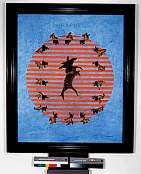 |
Terry Buchanan: A
Memoir of WW2 Shrapnel "During the war I found a piece of hot jagged metal in the garden. Our neighbour called it shrapnel. I kept 'shrapnel' in an empty Swan Vesta box until my mother threw it away. During my National Service (in Cyprus in the 1950s), I had closer encounters with the effects of violent force overtaking verbal dispute, and wondered...why in the age of political maturity and technological advance is shrapnel still considered a cost effective way to control disputed boundaries? Why are the children, fifty years later, still having to ask their neighbours for an explanation ?" Terry Buchanan was formerly Chief Photographer for the Royal Commission on the Historical Monuments of England. He studied printmaking at St Ives and Bath, and exhibited widely as a photographer during the 1960s. He lives in Chippenham, Wiltshire. top |
|
| War
Art And Artists: Objets d’art’
and the Paraphernalia of War |
||
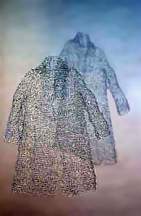 |
Kathleen Herbert: A Residency
in Bosnia "See but not Heard is a piece that I have made in response to my stay on Bosnia Herzegovina (which was made as part of an artists' exchange programme). The coat is made from galvanised wire which I have bent into text. I work from memory and as I bend the wire so the text unfolds. The text is thoughts and observations from my experiences of staying in a complex and fragile country. Bosnia is now (September 1999) coming to terms with the recent conflict and looking inwards at itself to re-evaluate its image to the outside world. It wants to be seen as a civilised and democratic nation. It is this conflict of image and reality that I was interested in and have illustrated by bending my personal experiences into text which makes up the article of clothing. we use clothing as a language reflecting how we wish to project ourselves and be perceived by the outside world." Contact: Bow Arts Trust Studios Ltd 181 - 183 Bow Rd. London E3. UK. top |
|
| War Art And Artists: Objets d’art’ and the Paraphernalia of War | ||
Elizabeth Turrell: Piece
and Peaces, ant-war enamels 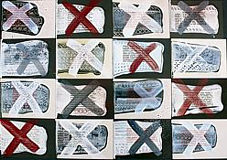
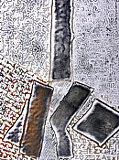 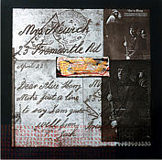 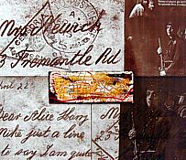 Turrell uses the medium of enamel in different ways to address her duel interests in the personal and political. One theme is an intimate celebration of the stitch. For generations of women, sewing and basic stitching have been quotidian tasks as well as intimate, portable, and often subversive means of expression. Turrell has always loved “white work,” especially mended and darned cloth, and she honors this labor in a series of monochromatic “samplers” of all white enamel on “sewn” copper foil.   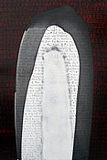 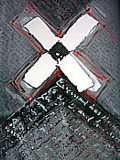 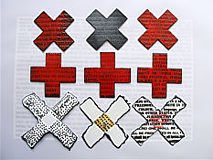 Conversely, Turrell’s overtly topical, political commentaries are produced on pre-enamelled industrial steel, using layered liquid enamels in a painterly application. With names like Friendly Fire and In Memoriam she explores “the broad theme of conflict as seen almost daily on the small rectangle of the television screen or newspaper photograph”. She conveys her revulsion with the “horrifying, but often removed and sanitized” news reports to which modern viewers may have become inured through repetition. She notes that “these news items often come with the ‘warning’ that the viewer may find them disturbing”. Tally of a War, a large, potent, but still intimate enamel on steel (34x 25cm), counts the war dead; it is cross-hatched, layered, and drawn, like a pen and ink drawing or graffiti scratched in a cell wall, with irregular circles X-ed out. Many, many circles, and many, many S’s count up the anonymous victims of war. Just as nothing is untouched in war, there is no space unmarked in the composition. On the surface these pieces refer to the Gulf War, but they may have their impetus is the crucible of Turrell’s childhood experience of World War II with her family in England, a theme to which she refers in an oblique way in her explicitly domestic fabrications. From a review by Marjorie Simon, a metalsmith and writer living in Philadelphia, Pennsylvania. Elizabeth Turrell was the former Senior Research Fellow in Enamel, Centre for Fine Print Research, UWE 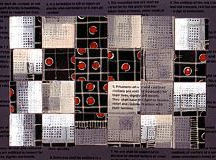 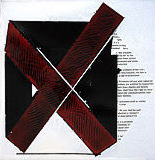 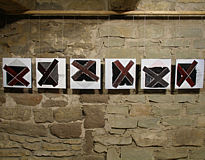 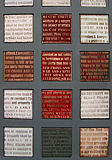 Simple repetition of form is powerfully employed in work by ElizabethTurrell. "Markers of Conflict" is comprised of a series of closely placed X forms covering a wall from below the waist to over one's head. Larger than a badge or brooch, too small to be a sign for conveying information to the public at large, these works are of the size and gesture to have been furtively marked on a door in the dead of night. Enameled surfaces pocked with gold, red, and glossy white illustrate physical wear and fatigue, with repeated perforations, scraps of text, and an obsessive marking that feels like tallying. Their individual characteristics prevent them from being consumed as mementos. Experienced simultaneously they bear witness to events too unbearably commonplace to comprehend, man's inhumanity to man. From 'Enamel - beyond the Object' catalogue essay by Kim Cridler, Arts/Industry Coordinator for the John Michael Kohler Art Centre, Exhibition at 'Spaces', Cleveland Ohio, June-August 2005 top back to featured artists |
||